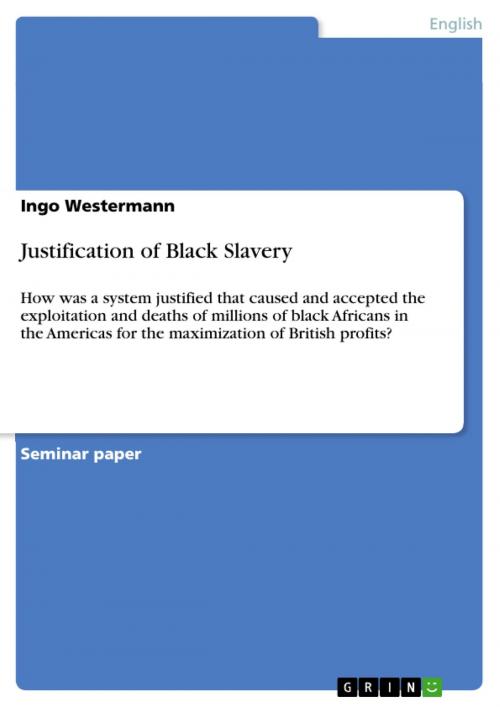Justification of Black Slavery
How was a system justified that caused and accepted the exploitation and deaths of millions of black Africans in the Americas for the maximization of British profits?
Nonfiction, Reference & Language, Study Aids, ESL, Foreign Languages| Author: | Ingo Westermann | ISBN: | 9783640619528 |
| Publisher: | GRIN Publishing | Publication: | May 11, 2010 |
| Imprint: | GRIN Publishing | Language: | English |
| Author: | Ingo Westermann |
| ISBN: | 9783640619528 |
| Publisher: | GRIN Publishing |
| Publication: | May 11, 2010 |
| Imprint: | GRIN Publishing |
| Language: | English |
Seminar paper from the year 2010 in the subject English Language and Literature Studies - Culture and Applied Geography, grade: 1,5, Carl von Ossietzky University of Oldenburg, language: English, abstract: In 1619 the first shipment of black Africans to British America arrived on the Atlantic coast of Virginia (cf. Morgan 2007: 21). This event marked the starting point for the development of a British large scale New World slave trading system that would eventually result in millions of Africans being deported from their home continent and shipped to the Americas. Black Africans were taken by force, put on a gruesome voyage over the Atlantic, sold as if they were goods instead of human beings and then put to work on plantations for the rest of their lives, while in all of these stages their deaths and that of many other fellow captives was readily accepted. From a today's point of view the described events and happenings appear utterly wrong, completely against any humane understanding, without any empathy for one's fellow being at all. A question that arises from this discrepancy between the existence of a near unquestioned system of transatlantic slave trade and the incomprehensibility and condemnation of the very same thing less than two centuries later is that of a justification. How was a system justified that caused and accepted the exploitation and deaths of millions of black Africans in the Americas for the maximization of British profits? Within this question, another, closely related aspect is already implied: Why was slavery within this system exclusively limited to black Africans? These are the two questions that I will focus on throughout the following pages. The goal for this paper consists of two parts. I will attempt to provide a basis that will help to understand how this system could come into existence in the first place and be maintained for as long as it lasted. This will require pointing out shortcomings of earlier, economically focused models and the introduction of several other influential components. The concept of a network with a multitude of interdependent factors will be the central element for this step. Secondly,I will take a closer look at religious motives, the related symbolism of the color black and the emergence of scientific racism, regarding their relevance and impact on the slave trade system and its maintenance. The final step of this paper will then consist of a last depiction of the network of reasons and explanations for the existence and sustenance of the British involvement in the transatlantic slave trade, visualizing the entanglement of multiple causalities
Seminar paper from the year 2010 in the subject English Language and Literature Studies - Culture and Applied Geography, grade: 1,5, Carl von Ossietzky University of Oldenburg, language: English, abstract: In 1619 the first shipment of black Africans to British America arrived on the Atlantic coast of Virginia (cf. Morgan 2007: 21). This event marked the starting point for the development of a British large scale New World slave trading system that would eventually result in millions of Africans being deported from their home continent and shipped to the Americas. Black Africans were taken by force, put on a gruesome voyage over the Atlantic, sold as if they were goods instead of human beings and then put to work on plantations for the rest of their lives, while in all of these stages their deaths and that of many other fellow captives was readily accepted. From a today's point of view the described events and happenings appear utterly wrong, completely against any humane understanding, without any empathy for one's fellow being at all. A question that arises from this discrepancy between the existence of a near unquestioned system of transatlantic slave trade and the incomprehensibility and condemnation of the very same thing less than two centuries later is that of a justification. How was a system justified that caused and accepted the exploitation and deaths of millions of black Africans in the Americas for the maximization of British profits? Within this question, another, closely related aspect is already implied: Why was slavery within this system exclusively limited to black Africans? These are the two questions that I will focus on throughout the following pages. The goal for this paper consists of two parts. I will attempt to provide a basis that will help to understand how this system could come into existence in the first place and be maintained for as long as it lasted. This will require pointing out shortcomings of earlier, economically focused models and the introduction of several other influential components. The concept of a network with a multitude of interdependent factors will be the central element for this step. Secondly,I will take a closer look at religious motives, the related symbolism of the color black and the emergence of scientific racism, regarding their relevance and impact on the slave trade system and its maintenance. The final step of this paper will then consist of a last depiction of the network of reasons and explanations for the existence and sustenance of the British involvement in the transatlantic slave trade, visualizing the entanglement of multiple causalities















